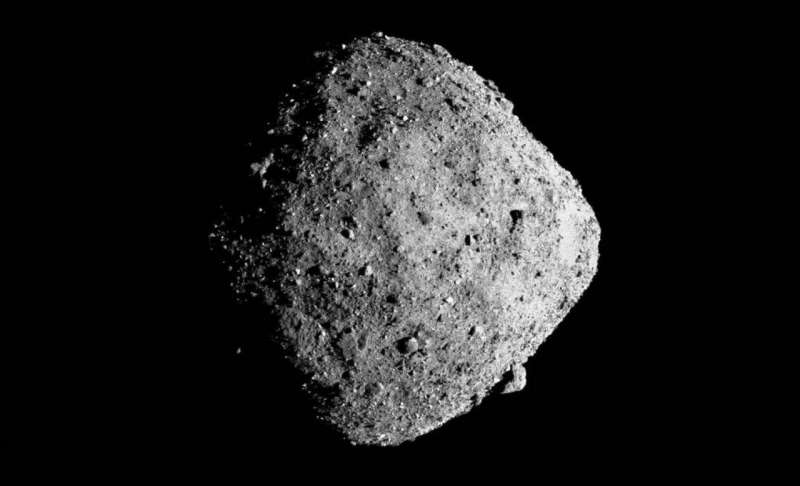OSIRIS-REx spies on the weird, wild gravity of an asteroid

Research led by the University of Colorado Boulder is revealing the Alice in Wonderland-like physics that govern gravity near the surface of the asteroid Bennu.
The new findings are part of a suite of papers published today by the team behind NASA's Origins, Spectral Interpretation, Resource Identification, Security-Regolith Explorer (OSIRIS-REx) mission. And they come just three months after OSIRIS-REx first encountered Bennu on Dec. 3, 2018.
Since then, the spacecraft has completed a few dozen laps around the asteroid, which is about as tall as the Empire State Building, circling Bennu from a distance of about a mile. And those early circuits are giving scientists a whole new look at this mysterious rock, said CU Boulder's Daniel Scheeres, who leads the mission's radio science team.
In research appearing in Nature Astronomy, for example, his team reports the mass of that asteroid: a respectable 73 billion kilograms.
But Scheeres and his colleagues are also working to develop a map of the asteroid's gravitational pull. Their findings suggest that Bennu exists in a delicate balance between two competing forces, the result of the asteroid's wild spin. Bennu completes a full revolution about once every four hours.
And, Scheeres said, those forces could play an important role in the asteroid's long-term evolution—and potential demise.
"When you spin this guy up, you create a competition between the gravity that's holding you down and the centrifugal acceleration, which is trying to throw you off," said Scheeres, distinguished professor in the Ann and H.J. Smead Department of Aerospace Engineering Sciences who leads the mission's radio science team.
To study those forces, Scheeres and his colleagues use OSIRIS-REx's navigational instruments to measure the minute tug that the asteroid exerts on the spacecraft.
And they dug up more than they expected. Based on the group's calculations, the region around Bennu's equator is trapped within a gravitational feature called a rotational Roche lobe—something that scientists had not yet clearly observed on an asteroid.
In practice, that feature gets weird. If you were standing inside the boundaries of Bennu's Roche lobe and slipped on a banana peel, for example, not much would happen—you'd be captured by the lobe and fall back to the surface.
"But if you were outside of the Roche lobe and slipped on a banana peel, you would roll toward the equator," Scheeres said. "And you could gain enough energy so that you'd roll off the equator and maybe up into orbit and then out into space."
It sounds like the sort of environment that Lewis Carroll could appreciate. But it also matters for the lifespan of Bennu, he added.
That's because radiation from the sun is causing Bennu to spin faster and faster over time. And as the asteroid's whirling builds up speed, its Roche lobe might also be shrinking, along with the forces that are holding Bennu together.
"As that Roche lobe narrows further and further around the equator, it becomes easier and easier for this asteroid to lose material," Scheeres said. "So far, that material has been trapped by gravity, but at some point, if the asteroid keeps spinning faster, then you fall off the cliff."
In other words, Bennu could be in the process of spinning itself into oblivion.
Understanding those physics matters for advance OSIRIS-REx's scientific mission, too, said Jay McMahon, an assistant professor in aerospace engineering and a co-author of the new study.
He explained that in 2020, mission scientists will nudge OSIRIS-REx to within a few feet of Bennu, using the spacecraft's retractable arm to collect a sample of material from the surface. And to do that safely, they will need to know the rock's physics inside and out.
"You need to know the gravitational field for spacecraft operations, really to enable all the other science," McMahon said.
"When you're going to a new world, you have some idea of what it might look like," Scheeres said. "Then you actually go there, and you can start comparing what you thought it might look like versus reality."
More information: The dynamic geophysical environment of (101955) Bennu based on OSIRIS-REx measurements, DOI: 10.1038/s41550-019-0721-3 , www.nature.com/articles/s41550-019-0721-3
Journal information: Nature Astronomy
Provided by University of Colorado at Boulder





















